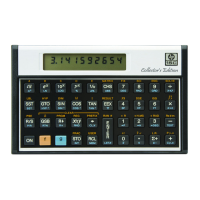124 Section 11: Calculating With Complex Numbers
Stack Lift in Complex Mode
Stack lift operates on the imaginary stack as it does on the real stack (the
real stack behaves identically in and out of Complex mode). The same
functions that enable, disable, or are neutral to lifting of the real stack
will enable, disable, or be neutral to lifting of the imaginary stack. (These
processes are explained in detail in Section 3 and Appendix B.)
In addition, every non-neutral function except − and ` causes the
clearing of the imaginary X-register when the next number is entered. That
is, these functions cause a zero to be placed in the imaginary X-register
when the next number is keyed in or recalled. Refer to the stack diagrams
above for illustrations. This feature allows you to execute calculator
operations using the same key sequences you use outside of Complex
mode.
*
Manipulating the Real and Imaginary Stacks
} (real exchange imaginary). Pressing ´ } will exchange
the contents of the real and imaginary X-registers, thereby converting the
imaginary part of the number into the real part and vice-versa. The Y-, Z-,
and T-registers are not affected. Press ´ } twice to restore a
number to its original form.
} also activates Complex mode if it is not already activated.
Temporary Display of the Imaginary X-Register. Press ´ % to
momentarily display the imaginary part of the number in the X-register
without actually switching the real and imaginary parts. Hold the key
down to maintain the display.
Changing Signs
In Complex mode, the ” function affects only the number in the real
X-register—the imaginary X-register does not change. This enables you
to change the sign of the real or imaginary part without affecting the
other. To key in a negative real or imaginary part, change the sign of that
part as you enter it.
If you want to find the additive inverse of a complex number already in
the X-register, however, you cannot simply press ” as you would
outside of Complex mode. Instead, you can do either of the following:
*
Except for the : and ; functions, as explained in this section (page 133).

